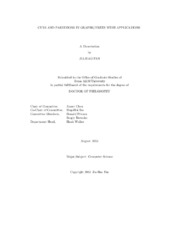| dc.description.abstract | Both the maximum agreement forest problem and the multicut on trees problem are NP-hard, thus cannot be solved efficiently if P /=NP. The maximum agreement forest problem was motivated in the study of evolution trees in bioinformatics, in which we are given two leaf-labeled trees and are asked to find a maximum forest that is a subgraph of both trees. The multicuton trees problem has applications in networks, in which we are given a forest and a set of pairs of termianls and are asked to find a cut that separates all pairs of terminals.
We develop combinatorial and algorithmic techniques that lead to improved parameterized algorithms, approximation algorithms, and kernelization algorithms for these problems. For the maximum agreement forest problem, we proceed from the bottommost level of trees and extend solutions to whole trees. With this technique, we show that the maxi- mum agreement forest problem is fixed-parameterized tractable in general trees, resolving an open problem in this area. We also provide the first constant ratio approximation algorithm for the problem in general trees. For the multicut on trees problem, we take a new look at the problem through the eyes of vertex cover problem. This connection allows us to develop an kernelization algorithm for the problem, which gives an upper bound of O(k3) on the kernel size, significantly improving the previous best upper bound O(k6). We further exploit this connection to give a parameterized algorithm for the problem that runs in time O∗ (1.62k), thus improving the previous best algorithm of running time O∗ (2k). In the protein complex prediction problem, which comes directly from the study of bioinformatics, we are given a protein-protein interaction network, and are asked to find dense regions in this graph. We formulate this problem as a graph clustering problem and develop an algorithm to refine the results for identifying protein complexes. We test our algorithm on yeast protein- protein interaction networks, and we show that our algorithm is able to identify complexes more accurately than other existing algorithms. | en |


